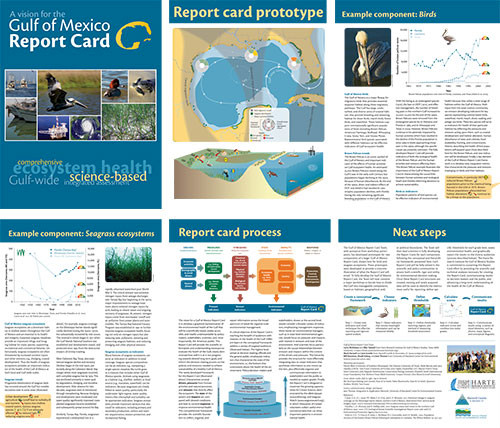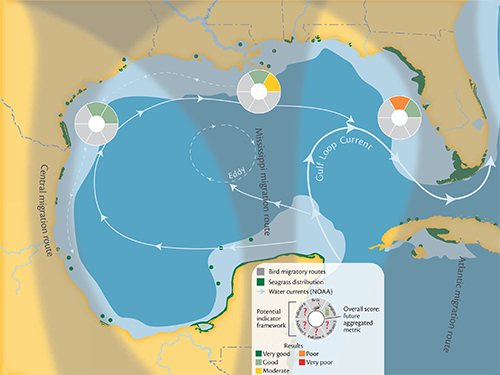Gulf of Mexico Summit 2011
Heath Kelsey · The Summit
Earlier this month I got to participate in what everyone hopes is a seminal moment for the future of the Gulf of Mexico. The Gulf Summit 2011 brought together invitees from scientific, academic, government, industry, NGO, and environmental law communities in the region for 5 days in Houston, Texas in early December.
Over 400 participants were treated to a week of interesting discussions representing widely diverse perspectives on global energy, ecosystem health, biology, marine protection, partnerships, and politics. The impressive list of keynote and plenary speakers included Lisa Jackson (EPA Administrator), Jane Lubchenko (NOAA Administrator), Nancy Sutley (Chair of the White House Council on Environmental Quality), Sylvia Earle (former NOAA chief Scientist), and former First Lady Laura Bush. These speakers and many others were passionate and inspirational in their love of the Gulf and their desire to improve it's health.
The Summit was impressive. The presentations were outstanding, and the energy behind the commitment to defining and achieving a sustainable and healthy gulf is remarkable. An interesting twist on a conference of this size is that all presentations were performed in plenary – there were no concurrent sessions and only one limited break out session. In concurrent sessions, we tend to migrate to the sessions that we're most familiar with, and end up hearing from our friends and colleagues, rather than the other sectors represented at the event. This format forced us all to hear other perspectives on the same issues.
The Gulf of Mexico Report Card prototype is unveiled
One of the highlights for me was the chance to talk report cards. We unveiled our vision for the Gulf of Mexico Report Card on Wednesday, with our partners from the Harte Institute, and Harwell Gentile and Associates LC. The report card prototype presents the look, feel, flavor and approach that we're envisioning for the full version that will come next.

For this prototype, we've developed two indicators to start with, recognizing that many more will be necessary. The two indicators are birds (represented by Brown Pelican in the prototype) and seagrass abundance. These two indicators were chosen because of their importance and for their recognition – both are widely recognized and both can serve as indicators of ecosystem health.
Birds are an important indicator of ecological health
The Gulf of Mexico is a major flyway for migratory birds that provides essential stopover habitat, breeding and wintering ground for a variety of bird species, including Brown Pelican, American Flamingo, Redhead, Whooping Crane, Sooty Tern, and Snowy Plover.
The Brown Pelican is an iconic symbol of the Gulf of Mexico and an important indicator of the effects of human activities on Gulf ecosystem health. An estimated 25,000 Brown Pelicans nested along the Gulf Coast in the early 20th Century. Populations began declining in the 1920s because of human disturbances and continued through the 1960's as a result of DDT and dieldrin use. With the listing as an endangered species (1970), the ban on DDT (1972), and effective management, the number of Brown Pelican breeding pairs in the northern Gulf increased to 20,000–25,000 by the end of the 1990s.

Brown Pelicans continue to be adversely impacted by human activities, which have resulted in the decline of the Florida population in since 1989 to levels approaching those seen in the 1960s, although the specific causes are presently unknown. The fully developed Report Card will provide indicators of both the ecological health of the Brown Pelican and the human activities and stressors affecting them. This Brown Pelican example illustrates the importance of the Gulf of Mexico Report Card in characterizing the causal links between human activities and ecological health and thereby informing decisions to achieve sustainability.
Seagrass provides an important habitat
Seagrass ecosystems are a dominant habitat in shallow waters throughout the Gulf of Mexico and are essential to its health and integrity. Expansive seagrass meadows provide an important refuge and foraging habitat for many species, supporting recreational and commercial fisheries. Unfortunately, seagrass ecosystems are often threatened by increased nutrient inputs and other stressors, like dredging and coastal development. The health of seagrass ecosystems provides an important indicator of the health of the Gulf of Mexico at both local and Gulf-wide scales.

Progressive deterioration of seagrass beds has occurred around the Gulf but notable recoveries exist in some areas (illustrated above), including Mississippi barrier islands, West Galveston Bay Texas, and Tampa Bay Florida. Trends were reversed by management and restoration efforts in thee regions.
Results are reported visually
The prototype also illustrates how these and other indicators could be reported visually, using a combination of maps and conceptual diagrams. This approach builds on previous report card projects like the Chesapeake Bay and the Great Barrier Reef. Results can be presented spatially, and individual indicators can be aggregated to present an overall score.

The report card seemed to be very well received at the Summit; everyone I spoke to afterwards thought it was something the Gulf sorely needed. Working with our partners, we hope this report card will advance quickly.
About the author
Heath Kelsey

Heath Kelsey has been with IAN since 2009, as a Science Integrator, Program Manager, and as Director since 2019. His work focuses on helping communities become more engaged in socio-environmental decision making. He has over 15-years of experience in stakeholder engagement, environmental and public health assessment, indicator development, and science communication. He has led numerous ecosystem health and socio-environmental health report card projects globally, in Australia, India, the South Pacific, Africa, and throughout the US. Dr. Kelsey received his MSPH (2000) and PhD (2006) from The University of South Carolina Arnold School of Public Health. He is a graduate of St Mary’s College of Maryland (1988), and was a Peace Corps Volunteer in Papua New Guinea from 1995-1998.

